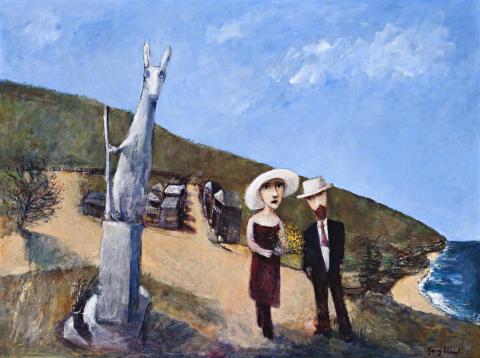THE SENTINEL, 1992 (FROM ‘D.H. LAWRENCE’ SERIES)
GARRY SHEAD
oil on canvas
91.0 x 121.0 cm
signed lower right: Garry Shead
signed and inscribed verso: The Sentinel Garry Shead
Michael Nagy Fine Art, Sydney, 1992
Company collection, Sydney
Company collection, Melbourne
Deutscher~Menzies, Sydney, 24 September 2008, lot 24
Private collection, London
The D.H Lawrence paintings marked the height of Garry Shead’s journey toward literary works which had fascinated the artist some two decades earlier. First reading the work of Englishman David Herbert Richards Lawrence during a 1968 trip to the Sepik region of Papua New Guinea, Shead shared an immediate spiritual affinity with the author, sensing their experiences of Australia were to be inextricably linked. Later, having moved with his wife Judith to Bundeena on the New South Wales coast in 1987, Shead drew comparisons to the nearby town of Thirroul where Lawrence wrote his novel Kangaroo while visiting Australia in 1922. So began a committed response to the words of Lawrence which had charmed Shead as a young man. The entire first series of D.H Lawrence paintings, comprising approximately fifty works, was completed within six months, demonstrating a vision of considerable intensity and clarity. In the tradition of Arthur Boyd’s Bride series and Sidney Nolan’s Ned Kelly series, the D.H Lawrence paintings oscillate between interpretations of reality and visions replete with mythology and poetic metaphors.
Of the D.H. Lawrence paintings, Sasha Grishin elucidates 'Shead's Kangaroo series is a personal, intuitive response to the novel rather than an attempt to illustrate the narrative. The imagery has much to do with the Lawrences at Thirroul, as with the characters in the novel. Richard Somers and his wife Harriet, of the novel, in the paintings appear as strange and ambiguous figures, at times taking on the features of Lawrence and Frieda, at others, having more than a passing resemblance to Shead and his wife Judith.’1 Typical of the series, the ambiguous figures in The Sentinel, 1992 serve as a caution against literal interpretation. Their identities unclear and complex, the man and woman waver between an embodiment of one of the three couples, and an indefinite combination of all. The kangaroo, armed with a rifle and standing tall above the figures is similarly ambiguous. Often theorised as a symbol of Kangaroo antagonist, political activist Cooley, the kangaroo motif featured across the series is the manifestation of a spiritual presence, rather than a tangible character. An omniscient adversary, the kangaroo in The Sentinel characterises the spirit of the place, its concrete formation ensuring a resolute and permanent gaze across the land and its trespassers.
The novel Kangaroo builds and maintains an enduring sense of anticipation, where the reader remains '... waiting, waiting for something to happen, waiting for this spirit of the land to strike’.2 Likewise, The Sentinel conveys a quiet suspense, as though the figures and the kangaroo, surveying their surrounds, are attempting to foretell their personal fate. The landscape, discernibly Australian with its rocky cliff sides and sweeping bush backdrop, is strangely timeless and as much an expression of Lawrence’s 1922 Thirroul as Shead’s coastal home of Bundeena. Rich with allegory, The Sentinel is a wonderful homage to Lawrence, bearing the prevailing lyricism and resonance of the much loved series to which it belongs.
1. Grishin, S., Garry Shead and the D.H. Lawrence Paintings, Craftsman House, Sydney, 1993, p. 14
2. ibid.
MELISSA HELLARD
